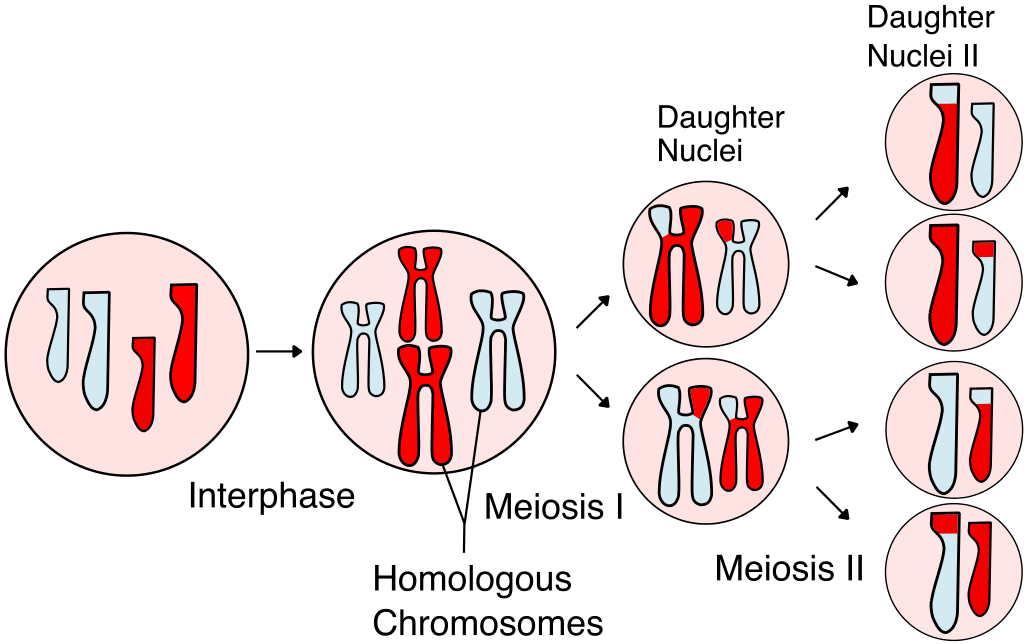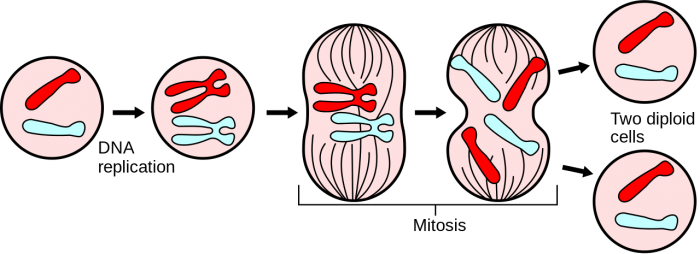
Meiosis is the process which creates sex cells, or gametes. During the process of meiosis, chromosomes are divided by half in order to create haploid cells. These parent cells that give birth to haploid cells are different from their haploid offspring, as the haploid cells have a genome which is distinct. The process of meiosis can be divided into two separate parts: meiosis one and meiosis two.
Meiosis one and meiosis two both have distinct phases. These phases are: prophase, metaphase, anaphase, and telophase.
During anaphase one, there are homologues that have been positioned on the metaphase plate during the previous phase, metaphase. In anaphase, these homologues are pulled on by the mitotic spindle, being pulled apart. After the homologues are separated, the spindle fibers pull them into opposite poles of the cell. During this phase, sister chromatids stay together, they aren’t separated by the spindle. There’s a difference in anaphase of meiosis versus anaphase of mitosis, because during the mitotic process spindle fibers from both poles of the cell are linked to the centromeres, while in meiosis spindle fibers extend from only one of the poles to link to the centromeres.
That’s basically what occurs in anaphase one of meiosis, but anaphase is only part of the meiosis process. Let’s examine the other phases of meiosis and discover how the actions carried out during anaphase play an integral role in a larger, complicated process.
Meiosis – The Creation Of Gametes
Meiosis is similar to the process of mitosis, the cellular process that divides cells to create new ones. Mitosis is the process that replaces old worn-out cells with new cells. Meiosis also divides cells to create new cells, but the process of meiosis is different from mitosis in several key ways. The primary difference between mitosis and meiosis is that meiosis is responsible for the creation of sex cells, or gametes.
Gametes are sperm and egg cells in humans, and when the sperm and eggs of different individuals are combined together a new genome will be created and portions of the genetic code from the original cells will be carried on. The daughter cells produced in meiosis have only half as many chromosomes as a parent cell, in contrast to the daughter cells produced by mitosis. While the process of mitosis produces diploid cells – daughter cells with two chromosomes sets – haploid cells possess only a single set of chromosomes. These haploid cells, the sperm and egg cells, will have their own diploid sets when they join together with other gametes.
Phases Of Meiosis

Photo: By Ali Zifan – Own work; Used information from Campbell Biology (10th Edition) by: Jane B. Reece & Steven A. Wasserman., CC BY-SA 4.0, https://commons.wikimedia.org/w/index.php?curid=49630204
Meiosis essentially uses the same mechanisms and strategies that mitosis does to separate the chromosomes within the cells. However, unlike the process of mitosis, meiosis must separate sister chromatids and homologous chromosomes, while mitosis must only separate sister chromatids. Homologous chromosomes are the non-identical chromosomes that a person will end up receiving from their parents. In order to separate both sister chromatids and homologous chromosomes, meiosis undergoes two cycles of division. The first cycle of division is meiosis one and the second is dubbed meiosis two.
Since the process of cellular division occurs twice, instead of just once like in mitosis, parent cells create four gametes – not two. Prophase, metaphase, anaphase, and telophase both occur in meiosis one and meiosis two.
Meiosis One
Before a gamete cell can go through meiosis one, it must proceed through Interphase. During Interphase, the sex cell grows in preparation for cellular division. As it grows, it makes copies of its chromosomes. When Interphase ends and meiosis one begins, the chromosomes that were copied in Interphase condense and pair up. Each of the chromosomes will align with a homologous partner. The chromosomes must be perfectly aligned with another, and the result is that the genes found on each of the chromosomes are running parallel to each other.
Crossing over is what occurs after the chromosomes have aligned. The process of crossing over is where the genes found on one chromosome break off from the chromosome, cross to the other chromosome and are stitched into it. This process takes place in-between the two chromosomes, with each of the chromosomes exchanging random genes. The chromosomes exchanging genes gives the DNA of the chromosomes greater diversity, and it is made possible thanks to a structure of proteins dubbed the synaptonemal complex.
Metaphase One
Metaphase may begin before or after crossing over, depending on the type of cell. During metaphase, the mitotic spindle uses the spindle fibers within it and captures the chromosomes. After the chromosomes have been linked to the mitotic spindle by the spindle fibers, the mitotic spindle pulls on these chromosomes and moves them towards the center of the cell into a region referred to as the metaphase plate. The process of mitosis also positions chromosomes on the metaphase plate, yet during the meiosis process the chromosomes are tied to microtubules found on only one and of the mitotic spindle. Because half of the chromosomes are linked to microtubules from one pole, individual chromosomes aren’t prepped for separation, homologous pairs are. Homologous chromosome pairs are randomly oriented.
Anaphase One
Anaphase one of mitosis one involves the homologs of the previous phases lining up on the metaphase plate. The homologs are then separated by the mitotic spindle, and after being separated by the spindle they are pulled to the opposing sides of the cell. Sister chromatids aren’t separated by the spindle and stay together into the next phase of the meiosis one cycle.
Telophase One
During telophase, the chromosomes that were pulled apart during anaphase finish moving to opposing ends of the cell. Some organisms decondense the chromosomes during telophase, and reform the membrane during this phase as well. Other organisms won’t reform the nuclear membrane. Since the cells will go through another round of meiosis, the reformation of the membrane isn’t entirely necessary during this phase. The process responsible for dividing one cell into two cells, cytokinesis, starts during telophase as well and after cytokinesis is completed two haploid cells will have been created.
Meiosis Two
When meiosis one completes, this cell preps itself for meiosis two, another round of cellular division. When meiosis two begins after the end of meiosis one, the DNA of the cell has not been copied. Meiosis two is shorter when compared to meiosis one, and it also a more simplistic process. Meiosis two is essentially mitosis for the haploid cells created during meiosis one.
The haploid cells that will undergo meiosis two begin the process with only a single chromosome, the result of meiosis one. The haploid cell chromosomes are made out of two sister chromatids, and these chromatids will end up separating during the rest of the meiosis process. At the end, there will be non-duplicate chromosomes and haploid cells.
Prophase of meiosis two sees the chromosomes condense and the nuclear envelope unravel if necessary. The mitotic spindle forms during prophase, and the centrosomes move to the opposite ends of the cell. The mitotic spindle has microtubules that capture the chromosomes. While this process begins in prophase it continues over into metaphase. Metaphase two also has the sister chromatids manipulated by the mitotic spindle, lining up on the metaphase plate just as occurred in meiosis one. During anaphase two, the cell preps itself for cytokinesis, and sister chromatids are split apart then dragged towards opposing ends of the cell.
The nuclear membranes begin to reform during telophase two, and the retrospective sets of chromosomes continue the development. Cytokinesis finishes during this step, and the two cells are divided into four cells. The chromosomes within these four cells are made out of a single chromatid, and now they are considered gametes or sex cells.
How Is Meiosis Different From Mitosis?

Photo: By Mysid – Vectorized in CorelDraw by Mysid from , Public Domain, https://commons.wikimedia.org/w/index.php?curid=1414818
Mitosis is different from meiosis is several key ways. The chromosomes line up on the metaphase plate during meiosis and mitosis, but unlike in mitosis, meiosis has paired chromosomes or tetrads which line up on the metaphase plate. By contrast, mitosis has single chromosomes line up on this plate instead. Another difference between mitosis and meiosis is that chromatids in mitosis can extend freely when they are in the mitotic spindle at the equator. In meiosis, however, the paired chromosomes are controlled in their orientation by the mitotic spindle and directed towards the poles of the cell. Another difference between meiosis and mitosis is that chromosomes are genetically identical in mitosis, while during meiosis the chromosomes are dissimilar because crossing over occurs.









